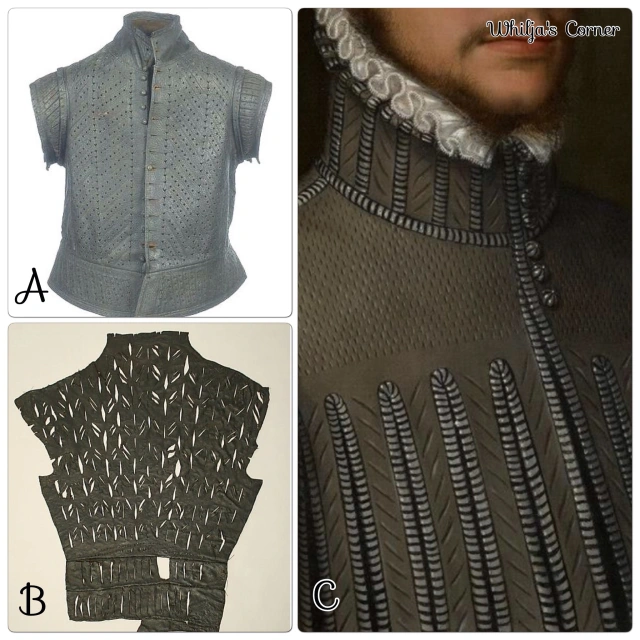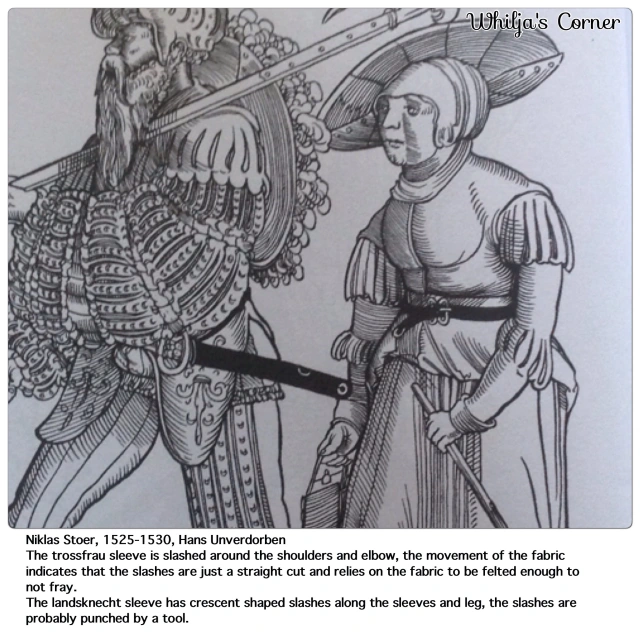Handsewn slashes may look very neat, but all of us who have done it also know that it is a very time consuming sewing technique, and requires a great amount of patient when you slowly work your way through slash after slash. When doing commissions for others I’ve have therefore been working on different period solutions and alternative to keep the cost down for the costumer, and make my outfits available for a larger group.
The slashing techniques I use can be defined in three different categories;
1) Hemmed slashes
A technique very useful for light weight wool fabrics, velvet, brocade or other fabrics that fray easily. (read more about how I use the technique on wool here). It’s most commonly seen on Saxon dresses.

A) “Herodias” by Lucas Cranach the Elder, 1530. The slashes seems to be stitched to prevent the fabric from fraying.
B) painting by Cranach. The shape of the slashes may inquire that it has been cut and the edges folded and stitched to the backside since brocade would be fraying to much to have just been cut open without any treatment.
C & D) paintings by Cranach. Another fabric can be seen along the outline of the fabric, indicated that each slash may be folded and the slashed seem is protected on the inside by lining with another larger piece of fabric, adding an extra decoration on the sleeve.
2) Straight cut slashes
The technique relies on the movement of the fabric to open up the slashes, some times padding is added to help

A) Detail from Holbein’s Martyrdom of St. Sebastian. The detail shows a close up of the slashings and if you use a felted wool and slash it, the fabric would behave very similar to the painting.
B) Detail from Graf’s The Bearer of the Banner Canton Glarus. The sleeves is slashed and then the slashing is slashed as well, which gives you a straight cut profile that indicates no treatment has been made on the slashes
C) Aldegrever’s Portrait of Albrecht Von der Helle. A slashed decoration on a goller, which has probably a adding underneath the puff fabric to give a it a raised look as well as open up the slashing.
3) Cut or punched slashes
Pinking tool has been found in England, and is basically a shaped sharp piece of metal which you punch a hole with. The shape of the hole is based on the shape of your tool. If you don’t have a pinking tool available in the right shape, cutting out the slash with a small scissors is also an option to achieve the right kind of slash.

A) Stoer, 1525-1530, Landsknecht Tailor
B) Breu the Elder, 1525-1530, Bastl Machenstreit/Profandmeister *
C) Breu the Elder, 1520-1530, Eberlein trit herein*
D) Schön, 1530, Landsknecht met Hellebaard*
Slashed surviving examples of Landsknecht clothing has not yet been found, and the most common surviving examples of slashed clothing is made out of leather; an example of the three different techniques on leather

A) Jerkin, England, 1550-1600. Pinked decoration in shape of stars, diamonds and hearts.
B) Doublet, England, 16th century. Cut slashes.
C) Painting of a Nobleman, Monogrammist GR (Germany) c. 1555. Slashed leather with possible metal thread decoration around the edges.
Which technique that is to be used may vary between where on the body of the garb I’m working on, what kind of material I’m using (light weight wool frays easier then felted wool, for example) and in some cases also on what type of status or trade the outfit is inspired from; a foot soldier or an officer or if they are a tailor or anything else.
What kind of technique used can’t always be determine by studying a woodcut or a painting, there isn’t enough details to study or the artist may have not consider that detail being important or sometimes you just can’t see if the slashing is cut or punched by a tool.
* woodcuts from Landsknecht Woodcuts; Kriegsvölker im Zeitalter der Landsknechte, G.A Johann, B. Enkevoerth, J. Von Falke

[…] attaching them I simply stretch the fabric slightly to open them up (read more about how to slash here). The front is side closed with hooks and eyes, just along the inside of the slashed band. The […]
Do you have any idea what the Cranach painting is that you referenced in A? I cannot seem to find a title anywhere.
The painting is “Herodias” by Lucas Cranach the Elder, 1530 (http://www.mutualart.com/Artist/Lucas-Cranach-the-Elder/92A025D918185DA9/Artworks?Params=3936382C43757272656E74506167652C322C31)